
The history of South Korea begins with the Japanese surrender on 2 September 1945. At that time, South Korea and North Korea were divided, despite being the same people and on the same peninsula. In 1950, the Korean War broke out. North Korea overran South Korea until US-led UN forces intervened. At the end of the war in 1953, the border between South and North remained largely similar. Tensions between the two sides continued. South Korea alternated between dictatorship and liberal democracy. It underwent substantial economic development.

The president of the Republic of Korea, also known as the president of Korea, is both the head of state and head of government of the Republic of Korea. The president is elected by citizens of the Republic of Korea and pledges to execute the duties of their office, chief among others "to defend the State, pursue peaceful unification of the homeland." The president leads the State Council, is the chief of the executive branch of the national government and the commander-in-chief of the Republic of Korea Armed Forces.
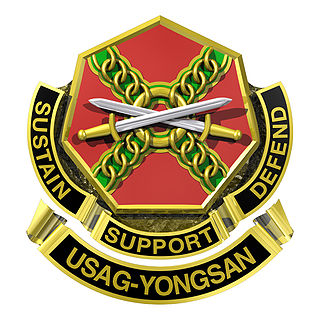
Yongsan Garrison, meaning "dragon hill garrison", is an area located in the Yongsan District of central Seoul, South Korea. The site served as the headquarters for U.S. military forces stationed in South Korea, known as United States Forces Korea (USFK), and as United States Army Garrison Yongsan (USAG-Yongsan) until 2018, under the supervision of the U.S. Army's Installation Management Command Pacific Region. From 1910 to 1945 it served as headquarters for the Imperial Japanese Army in Korea.
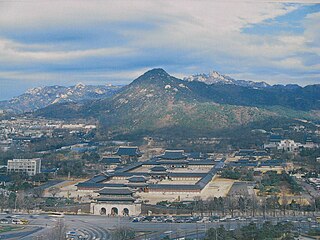
Gyeongbokgung, also known as Gyeongbokgung Palace, was the main royal palace of the Joseon dynasty. Built in 1395, it is located in northern Seoul, South Korea. The largest of the Five Grand Palaces built by the Joseon dynasty, Gyeongbokgung served as the home of the royal family and the seat of government.
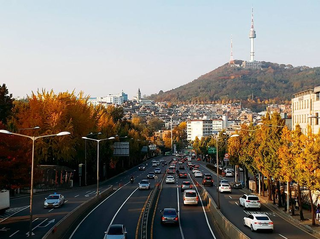
Yongsan District is one of the 25 districts of Seoul, South Korea.
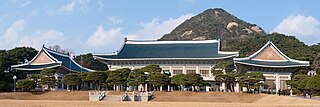
Cheong Wa Dae, also known as the Blue House in English, is a public park that formerly served as the presidential residence and the diplomatic reception halls of the Republic of Korea from 1948 to 2022. It is located in the Jongno district of the South Korean capital city of Seoul.

Park Geun-hye is a South Korean politician who served as the 11th president of South Korea from 2013 to 2017.

The government of South Korea is the national government of the Republic of Korea, created by the Constitution of South Korea as the executive, legislative and judicial authority of the republic. The president acts as the head of state and is the highest figure of executive authority in the country, followed by the prime minister and government ministers in decreasing order.

Diplomatic relations between South Korea and the United States commenced in 1949. The United States helped establish the modern state of South Korea, officially the Republic of Korea, and fought on its UN-sponsored side in the Korean War (1950–1953). During the subsequent decades, South Korea experienced tremendous economic, political and military growth.

The National Assembly Proceeding Hall is a building in Yeouido-dong, Yeongdeungpo District, Seoul which serves as the location of the National Assembly of the Republic of Korea, the legislature of South Korea.

Moon Jae-in is a South Korean politician who served as the 12th president of South Korea from 2017 to 2022. Before his presidency, he served as Senior Secretary for Civil Affairs and Chief of Staff to President Roh Moo-hyun, Member of the National Assembly, and Leader of the Democratic Party of Korea.

Byun Hee-jae is a South Korean conservative political commentator. He is also one of the founder of conservative weekly newspaper name Mediawatch.

Choi Soon-sil is a South Korean businesswoman known primarily for her involvement in the 2016 South Korean political scandal, stemming from her influence over the 11th President of South Korea, Park Geun-hye. In 2018, a court sentenced Choi to 20 years in prison on corruption charges. Due to Choi's concurrent involvement in her father's religious cult, reporting media have called her "South Korea's Rasputin", in reference to Russian mystic Grigori Rasputin.

Yoon Suk Yeol is a South Korean politician and attorney who has served as the 13th president of South Korea since 2022. A member of the People Power Party (PPP), he served from 2019 to 2021 as the prosecutor general of South Korea under his presidential predecessor, Moon Jae-in.

The People Power Party, formerly known as the United Future Party, is a conservative and right-wing political party in South Korea. It controls the South Korean presidency and is the second-largest party in the National Assembly. The PPP, along with its historic rival, the Democratic Party, make up the two largest political parties in South Korea.
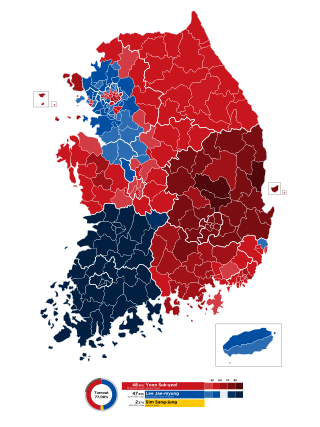
Presidential elections were held in South Korea on 9 March 2022. Under the South Korean constitution, presidents are restricted to a single five-year term, meaning that incumbent president Moon Jae-in was ineligible to run for a second term. Opposition candidate Yoon Suk Yeol of the People Power Party won the election, defeating candidate Lee Jae-myung of the incumbent Democratic Party.
The following lists events in the year 2023 in South Korea.
The following lists events in the year 2024 in South Korea.
The following is a list of events from the year 2024 in North Korea.

Kim Yong-hyun is a former South Korean Minister of National Defense who served within the cabinet of President Yoon Suk Yeol from 6 September 2024 until 5 December 2024.



















